pg. 18
sports commits
pg. 6
VOLUME XVI ISSUE IV
FUNDED BY THE PTA

pg. 18
pg. 6
VOLUME XVI ISSUE IV
FUNDED BY THE PTA




Hey, Bears!
Summer is here, and so is our final Mark!
From investigating cultural phenomenons to exploring a local monastery, our journalists have worked hard to bring light to all corners of our community this year. Our steadfast coverage has also been recognized nationally: just a month ago, we received the National Student Press Association’s Online Pacemaker Award, one of the most prestigious honors in high school journalism.
To top off the year, our theme for this Mark is... shapes and colors?
This special graduation edition of the Mark celebrates our seniors and encourages them to step into the world as their boldest, brightest, and most colorful selves—each uniquely shaped by their time at M-A.
As we transition to our new Editorial Board, we’d like to thank our past editors for their dedication to the program and the PTA for providing the funding to do what we love. Last but not least, thank you to all students and staff—without your voices, our stories wouldn’t be possible.
Have a great summer, and see you next year, The M-A Chronicle Editorial Board



Editors-in-Chief



Gaby Foster, Becca Koenig
News Editors
Leah Collins, Isabel Habibi, Alessandra Hartwig
Events Editor
Jenna Lee
Design Editor
Caitlin Smith
Social Media Manager
Amari Witt
Copy Editors
Morgan Baudler, Celine Chien, Tessa Ellingson, Allegra Hoddie, Louisa King, Siboney Lynch, Maeve Miller, Ameya Nori, Huraman Orujov, Lindsay Park, Alli Schindler, Ben Siegel, Ella Thomson, Celeste Zucker
Advisor
John McBlair
Culture & Features
Editor
Rose Chane
Sports Editor
Ben Warner
Staff Writers
Caroline Baker, Oliver Bain, Delilah Bellis Rivera, Taylor Bentley, Katelyn Chao, Aliyah Chowdhary-Fitton, Paulina Cisneros Arreguin, Ilaria Cline, Kitty Cormican, Mateo Cuellar-Koh, Anna Dearing, Farah Ghajar, Parmis Hoghooghi, Kritya Kiran, Akemi Kwan, Bailey Lanier, Colin Lee, Lia Lev, D’Anjou Paul Libunao, Eileen Liu, Liri Maoz, Sophie Marks, Karen Martinez, Abby Medin, Teagan Murphy, Joe Pagee, Julinka Pang, Zara Parekh, Alisha Parikh-Briggs, Santi Quesada Tevis, Emily Pecore, Ellie Rosen, Micaela Rubinsky, Tatiola Sobomehin, Varsha Sripadham, Hana Suzuki, Charlie Tobin, June Wagner, Leilani Wallace, Ivy Watrous, Jonathan Weeks, Benji Weiss, Lilia Wilkiewicz, Jovi Wong, Weycene Yang, Miya Yu






Read about an administrative specialist at Meta, a water polo player turned ER nurse, a journalist with his own consulting company, and a software engineering program manager for Apple in our column featuring accomplished alumni.
by Rose Chane
designed by Ben Siegel photos courtesy of Jennifer Zamora Flores, Becca Dorst, David Morrill, and Damali Ankoanda-King
“My path wasn’t exactly straightforward. I didn’t take the typical college route, yet I found my way to Meta,” Jennifer Zamora Flores ’16 said. Flores works as an administrative specialist at Meta, handling scheduling, coordination, and team support.
Flores was in Leadership as a junior and senior. “Leadership was one of the first times I got really involved at M-A, and it was rewarding to plan events and give back to the community,” Flores said.
After M-A, Flores attended Cañada College, initially studying nursing and science. “I started taking chemistry classes and realized it wasn’t for me, so I ended up switching my major to sociology,” she said.
After Cañada, Flores joined a program called Year Up, a oneyear educational program that included in-classroom training and a six-month internship. “I got placed at Meta for my internship as a recruiting coordinator, where I scheduled interviews for potential candidates and helped with project management,” she explained.
Flores now works as an administrative specialist at Meta and supports the marketing of teams like Reality Labs.
“It’s really cool to see all the different sides of Meta,” she said. “Most people only think of Instagram and Facebook, but I get to see the behind-the-scenes and what it takes to build those teams.”
Flores’ advice to current M-A students: “Do a lot of research on the help and scholarships available for colleges. There are so many options and different paths to take, so choose the right one for you.”
ater polo has taught me discipline and perseverance, which now applies to my work as a nurse,” Becca Dorst ’10 said. Dorst was a water polo star at M-A and now works as an ER nurse.
At M-A, Dorst played varsity water polo all four years, coached by Chris Rubin. “Coach Rubin was the best coach to learn from and go through M-A water polo with,” she said.
Dorst was inducted into M-A’s Athletic Hall of Fame this past October. “I was inducted with my sister Emily, which was such a full circle moment for us,” she said.
After graduating from M-A, Dorst attended UCLA, where she played water polo and earned an All-American title. Following college, Dorst moved to Australia for a year and played water polo professionally. “I got the opportunity to play professionally and just couldn’t say no. I mean, it’s Australia,” she said.
Dorst served as the assistant women’s water polo coach for two years and interim head coach for one year at Princeton University. “I was really interested in coaching because it felt like I was giving back to the community that shaped me,” she said.
While coaching at Princeton, Dorst took prerequisite courses at a New Jersey community college before enrolling in an accelerated nursing program at Concordia University.
Dorst now works as a day-time ER nurse at Mission Hospital in Orange County. “I love nursing because I love helping people and being a positive influence in anyone’s life,” she said.
Dorst’s advice to current student-athletes: “Enjoy the hard work. I know it’s easy to think the end goal is a championship, but the people and the dedication are where you’ll find your true joy.”






was always a pretty good writer, but I was shy and didn’t talk much, so I decided to scare the voice out of me with journalism,” David Morrill ’91 said. “It brought out a lot of my personality.”
At M-A, Morrill competed in track and field, where he was named most valuable player twice. Morrill also wrote for M-A’s newspaper, called Bear Tracks at the time.
After high school, Morrill majored in journalism at the University of Colorado Boulder. He joined the local newspaper, the Colorado Daily, as a sports editor and department manager. Before his senior year of college, Morrill worked at the Chicago Tribune in the Washington Bureau, covering the 1996 presidential race. “I learned early on that if you’re a student, you can ask anybody anything, but once you’re not, it’s harder to get people to talk to you,” Morrill said.
Following college, Morrill worked at various newspapers, including The San Diego Union-Tribune, The Desert Sun, and the Oakland Tribune. “I’ve talked to notable people like Michael Jordan, but I enjoy the stories about unsung heroes,” he said.
Morrill also founded his own company, ROI Catalysts, a consultancy focused on strategic communication and media marketing. He currently works with The Golf Magician as his director of marketing and content. “He’s one of my childhood idols, and I ran into him at a lecture and asked if I could work with him,” he said.
Morrill’s advice for current M-A students: “Build as many skill sets as you possibly can and connect with people you don’t normally hang out with. Reach out to companies, talk to them, and get your name out there.”
Damali Ankoanda-King ’92 is a software engineering program manager for Apple, specializing in systems engineering. “Being able to work with a team and resolve obstacles is a very rewarding experience,” she said.
At M-A, King’s favorite class was computer-aided design. “It gave me an introduction into what I would later see working in software and sparked my interest in engineering,” she said.
King also participated in M-A’s Black Student Union. “At the time, there was not a huge African American population at M-A, so BSU was a chance for everyone to come together from their unique backgrounds,” she said.
After M-A, King attended Howard University to study mechanical engineering. “When I was younger, I would always try to fix things around the house, like the VCR or a doorknob, so I was in tune mechanically,” King said. “One of my mom’s friends told me I should be an engineer, which stuck with me from a young age.”
Following college, King joined Lockheed Martin, a leading aerospace and defense company. She then earned her master’s degree in systems engineering from the University of Pennsylvania and worked as a test engineer lead and mechanical design engineer at Lockhead Martin. “One of the biggest projects I worked on was a Japanese ballistic missile defense program, where I got to travel to Japan,” she said. Currently, King works as an engineering program manager at Apple, managing the development of new features and applications.
King’s advice for current M-A students: “Find teachers who are not only mentors in school but also in life.”


“Don’t let anyone tell you something can’t be done, and do it if it’s something you really care about. Don’t give up when it gets hard.”


“Do your research on the schools and teams before getting involved, and make sure to pick somewhere that truly benefits you. Stay focused and calm throughout the entire process.”


“It’s the time that coaches don’t see you working and the behind-thescenes that end up getting you to where you want to be. It’s late-night and early-morning practices that get you an extra step ahead of your competition.”


“Reach out and get into contact with coaches as soon as possible, as roster positions fill quickly. But remember to stay patient and not be discouraged.”

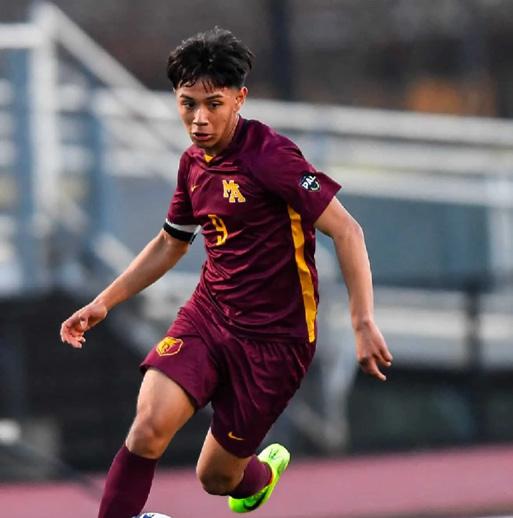
“Have grit to do the things you hate, like running or strength training, because if you do it, you’ll always come out successful.”




“The players at Washington weren’t interested in the glitz or glam associated with playing football at that level. They were more interested in the process than the results and building a brotherhood, which is important to me.”
“The hardest part was definitely during the summer of junior year when I was reaching out to as many coaches as possible and had a tournament, prospect camp, or event every week.”


“I was motivated to row in college because I couldn’t picture myself parting with the sport so soon. I often find myself thinking about what I would do if I didn’t have rowing, and I seriously have no idea.”


“It was a constant day-after-day grind for about two years. There were lifts five times a week and practices or tournaments six days a week, so it was hard. Keep your grades up, keep your diet strong, and always ask your coach questions.”




“When I first visited the campus, I knew I was going to play there. I felt so connected with the coach and loved the team’s energy.”


“Growing up, I never thought I would have a chance to play at the next level, but luckily, I had great coaches who helped me believe I could get there.”
“More than anything, I love water polo, and I felt that going to Cal would give me the best opportunity to keep growing both as a player and a person.”


“Although the process may be stressful at times, the effort put into it will pay off regardless of which college you go to.”


“Do it for you. Proving myself right and showing what I could do is what motivated me throughout the process.”


“It was really tough and there were a lot of sacrifices, but staying positive and trusting the process was key. I learned to keep my head up and focus on what I could control.”


“I had to move around many different clubs, and I was lucky to have really good coaches dedicated to helping me grow as an athlete. My parents were also super supportive and helpful while I looked through all my options, even if they were far away.”


“Columbia was my first offer, and I felt like I had loyalty to them. They believed in me before other schools did, which caused me to have a great relationship with the coaching staff.”


“My parents supported me and pushed me when I felt like giving up or when they knew I could do better for myself. I am very thankful for my coach’s advice and help navigating the recruitment process.”
Juniors Addison Finn and Hailey Preuss, and senior Natalie Scafetta found considerable success in the pool, and they helped the girls swimming team stay triumphant in the league with an 8-0 record. In the CCS Championship, the girls came in eighth place. The boys swimming team secured third in PAL with a 5-3 record and came in 15th in CCS Championships.






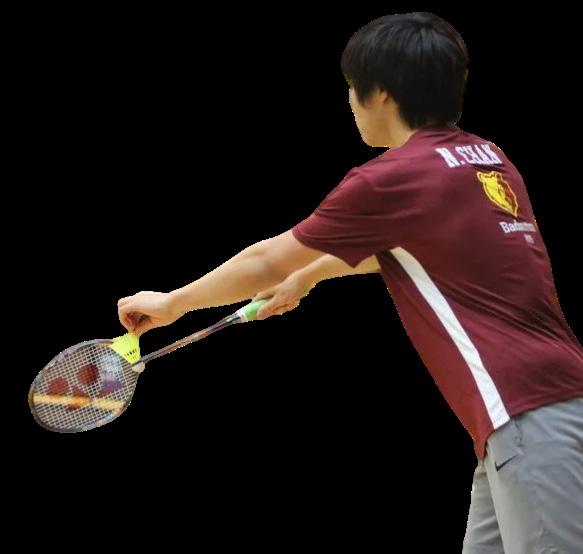


The badminton team finished with a solid 6-8 record, giving them fifth place in league. Senior captains and mixed doubles team Addison Youngblood and Weycene Yang triumphed on the court, while senior Katelyn Chao dominated the singles court.



The boys volleyball team controlled the league, finishing first with a 10-2 record. The team was led by senior commit Peter Chriss, who was also named PAL player of the year. The boys were seeded second in CCS Division I, but were upset by Carlmont in four sets in quarterfinals.





by Tessa Ellingson designed by Becca Koenig photos courtesy of Morgan Baudler, Anna Dearing, D’anjou Paul Libunao, Siboney Lynch, Sophie Marks, Julinka Pang, Aisha Swayzer, and Ben Warner


The girls lacrosse team had a difficult year in the WBAL Foothill Division as the only public school in the league. Even though the girls finished the season 2-8 in league play, dedication from senior captains Ruby Pence and EB Hoffman kept morale high. The girls placed in CCS Division I but fell to Saint Francis 3-13 in the first round.



The boys tennis team finished second in league with a 10-2 record after losing in PAL finals. The team qualified for CCS and played Evergreen in the first round, where they fell 0-7 to conclude their season.


The track and field team consistently found their way to the podium in league with senior Sara Nordlund leading in the hurdles, senior Alex Petry in the 200M and 400M, and junior Cason Mitchell in the 3200M. After CCS Trials, six runners qualified for CCS Championships.
Dominating the season, the baseball team finished first in league with a 12-2 record and a 20-7 overall record. The team was led by juniors second baseman Ryder Kelly and pitcher Wes Peterson, as well as senior first baseman Jimmy Zaharias. The team qualified for CCS Division II.
The boys lacrosse team breezed through league play, securing first place in PAL. Offensive help from senior attacker Colin Kryger and senior faceoff Eric Torre as well as tight defense from senior goalkeeper Olivier Yuk, allowed the team to hold an impressive 10-0 PAL record and 13-3 overall record. The boys were the only public school in CCS Division I, where they were defeated by Saint Francis 6-10.
The softball team found difficulty in the PAL Ocean division, holding a 4-6 record and fourth place in the league. Regardless of their standing, the team found success with sophomore second baseman Juliana Pandolfo and sophomore pitcher Grace Nava dominating the mound.
“It’s not a team. We call it a family,” Razorhawks assistant coach Alo Sanft said.
Every Tuesday and Thursday, cars flood East Palo Alto’s Rich May Field parking lot. Kids excitedly run to practice as parents greet each other with hugs and laughter.
The EPA Peninsula Rugby Football Club, or the Razorhawks, was founded in 2015 when the preexisting Razorbacks and Seahawks teams combined.
All teams practice simultaneously in designated areas of the field. “The little kids can look up to all the bigger kids and get an insight into what it looks like to play high school rugby while strengthening the program’s bond,” M-A junior Lucy Sanft said.

“I think our team is just different,” Paly junior Paula Pongi said. “We’re from EPA—nobody knows about us. I like being looked at like the underdogs.” Despite representing such a small city, the Razorhawks maintain a legacy of victory in their various age-level leagues.
“Rugby has expanded a lot, and many colleges are starting to bring it into their programs,”
Coach Rob Peterson said. “The neat thing is a lot of these kids have an opportunity to further their education and get into more schools because of the game.”
“Our tournaments help you get noticed since scouters are there. If you play well, they’ll come and talk to you about playing for their school,” M-A junior Antonina Tangilanu said. “There’s so much guidance from this team that you can get if you want to play in college.”
Several Razorhawks coaches played at the collegiate level, and this year, the Razorhawks have 10 alumni attending schools for rugby.
“It’s not a team. We call it a family.”
- Coach Alo Sanft
Another pillar of the program is its dedication to community connection and engagement. “Coach Dave ‘TD’ took a lot of kids off the streets that were getting wild. He gave us something to do after school,” Razorhawks Vice President Sione “Palei” Tu’ipulotu said about playing on the inaugural Razorbacks team in 2002.
After the Razorbacks merged with the





teams.
“[I came to the Razorhawks team] to give every kid the opportunity to experience what leadership, respect, discipline, hard work, teamwork, and accountability look like in the game of rugby, which can translate into life,” President Vaea Sanft, who also played for the Razorbacks, wrote on the Razorhawks website.
The Razorhawks embody EPA’s community-driven spirit with their unconventional approach to often over-competitive, unenjoyable, and overpriced club sports leagues. Even with inexpensive registration fees, they offer scholarships to families who need them most and hope to provide more financial support with increased funding.
“My favorite part of the team is seeing our young girls grow into the sport and the encouragement they receive,” parent Joyce Latu said. “Female ruggers are something that you don’t see often.”






EPA’s predominantly Black, Polynesian, and Latino population influences the team’s demographics. “I feel like rugby is a sport that can bring everyone together, especially Pacific Islanders,” Vaea said. Rugby is popular in many Polynesian islands, like Tonga, where it is the national sport. “I think it’s good to have people that you relate to so you can feel like you belong,” Lucy said of playing with Polynesian peers from EPA.
“I was part of the Tinsley program, so my life was very much in Palo Alto despite living in EPA,” Latu said. “Since my kids are also in the program, I try to balance it. If they’re going to school in Palo Alto, then they’re going to do extracurricular activities here so that they can be immersed in our own community and feel a sense of home.”
Players come from across the Bay Area to participate in the Razorhawks experience. “I’ve made a bunch of friends
here since I was a little kid,” Gunn High School senior Dominic Peterson, who has been playing rugby for eight years, said. “The people are the reason I keep coming back. Each year I play, I get to know more people from EPA, so it definitely feels like a second home.”
“The people are the reason I keep coming back. Each year I play, I get to know more people from EPA, so it definitely feels like a second home.”
- Gunn senior Dominic Peterson
After hours of practice, teams gather in a huddle to discuss upcoming schedules, hold a group prayer, and end with a celebratory pizza party.


“No matter what your background is, if you come here, you’re our family,” Alo said. “We look out for each other. Whether you can make it to practice or not, we’ll look out for your kids.”
by Tatiola Sobomehin designed by Tatiola Sobomehin photos courtesy of Tatiola Sobomehin



Ravenswood High School was a part of the District from 1958 to 1976. When it opened, the school served 629 students from East Palo Alto and Belle Haven.
When EPA experienced “white flight” in the early 1960s, the Congress of Racial Equality and the NAACP became uneasy about the school nearing an all-Black student population. At the time, Ravenswood was 60% Black and growing.
for a week. Each year, five students would go to another school, and their students would come to Ravenswood to experience being in a ‘diverse setting.’”
In 1971, following the Supreme Court’s decision in Swann v. Charlotte-Mecklenburg Board of Education, the District initiated a busing program to desegregate schools.
As a result, students originally districted to Ravenswood could bus to schools like Carlmont and M-A. Similarly, students who would have gone to other District schools could attend Ravenswood.
Mothers for Equal Education, a local group, advocated for the school’s closure and for students to attend primarily white schools, which they believed could provide a better education. Beginning in 1965, some students lived with Palo Alto and Los Altos families for two years to attend school outside of EPA in a project known as “Sneak-out.”
In 1968, the District instituted a transfer program that allowed Ravenswood students to briefly attend predominantly white schools, while students from those schools could temporarily attend Ravenswood.
Peter Katz, an alum who was bused from Portola Valley, chose to attend Ravenswood. “One of the things that the school did was go around to different feeder schools and talk about a program where all the teachers and students would help build the school together. They wanted to do things in a new and innovative fashion,” Katz said.
Martha Goodwill Hanks, an alum and president of the Ravenswood High School Alumni Association, participated in this transfer program. “My senior year, I was an exchange student at Carlmont High School
Ravenswood High School’s curriculum and teaching philosophy was more experimental than other District schools. “My cousin was having problems at school, so his mother had me go to Ravenswood and talk to his counselors. By then, students from other schools were going to Ravenswood because it was such a different experience. They had skiing classes,” Hanks said.
“It was more like a college campus,” Katz said. “We had classes that were all over the map. We had

regular math and science, but then we’d have things that were a bit more creative. For example, you might take four different history classes because we had a modular schedule. One might cover the roaring ‘20s and another might cover the Arab-Israeli conflict.”
Despite its success in attracting new students, the racial tensions at Ravenswood steadily worsened. In addition to multiple race riots, EPA began hosting Black Power summits, which raised the question of whether schools ought to integrate in the first place.
As conflicts among the school community increased, parents became reluctant to bus their students to Ravenswood. Between 1963 and 1974, the student population dropped from 1,205 to 823. The dwindling student population, along with budget problems, encouraged Ravenswood to close its doors in 1976, making way for the Gateway 101 Shopping Center.
Following Ravenswood’s closure, students were bused to other District schools. “When my son went to high school, they wanted to send him to Carlmont. I told the district, ‘No, he’s going to Menlo-Atherton—if I need to get to him, he should be close enough that I can drive over and see what’s going on,’” Hanks said.
Eventually, with the help of the Lawyers’ Committee for Civil Rights in 2013, parents like Hanks convinced the board to send most EPA students to M-A.
With regular reunions and a close community of alumni, Ravenswood’s legacy prevails. “I helped put on one of the class reunions. I’m in very regular touch with a lot of people,” Katz said.
by
Siboney Lynch designed by Micaela Rubinsky photo courtesy of EPA Community Archive



Just a short walk from M-A along Oak Grove Ave. stands an elegant white chapel complete with stained glass windows and a neo-Gothic bell tower. The building, hidden behind trees and shrubs, is part of Corpus Christi Monastery and is home to Menlo Park’s Dominican nuns.
“I guess you could say we’re professional prayers,” Sister André Marie said. “Our monastery was founded for the purpose of having adoration and enduring Jesus in the Blessed Sacrament, so our whole life is ordered towards that.”
The Menlo Park monastery was built in 1921, but the Dominican nuns’ history dates back to 1206, when Saint Dominic founded a monastery in Prouille, France. Today, over 25,000 Dominican friars, nuns, priests, and laypeople dedicate their lives to preaching, sim-
plicity, and community.
“As Dominican nuns of the Order of Preachers, we participate in the preaching missions of the friars,” Sister André Marie explained. The nuns hold a public mass every day at 8 a.m. where they sing hymns, listen to a sermon, and receive the Eucharist. Also known as the Blessed Sacrament, the Eucharist honors Jesus’s blood and body. “Corpus Christi” itself means “body of Christ” in Latin.
The nuns also pray before the Blessed Sacrament. “What drew me to the monastery is that they have the adoration of the Blessed Sacrament,” Sister André Marie said. “I wasn’t thinking of becoming a nun, but I went to a conference one weekend and when I went home, I just felt that the Lord’s presence was very strong and powerful in the Blessed Sacrament. When I’m before our Lord there, I feel a lot of peace and joy that cannot be fulfilled anywhere else.”
“We all have a mission in life. I went to school and got a degree, but then I felt like there was something still missing in my life,” Sister Joseph Marie said. “When I found the monastery, it just spoke to me. Praising God filled that emptiness. God gave me that joy.”
“God wants to give us so much, and a lot of times we just don’t pay attention or think about how the air that we breathe every day is from God,” she added. “It’s God who gives us that source of life, and so our life is to thank God, to praise God for that gift that he gives to all society.”
The nuns maintain a strict prayer schedule that begins at 5:35 in the morning and ends at 7:30 in the evening. In total, they spend at

least two hours a day on personal prayer. “First we pray for ourselves, then we pray for our sisters that we live with, the community, the neighborhood around us, the young people, and the whole world,” Sister André Marie explained. “We also receive prayer requests from all over the place, all over the world sometimes, from Christians and non-Christians too.”
“When you start a school year, we pray for all the young people, because you are the future,” Sister Joseph Marie said.
“It’s been said that we are the heart of the church,” she added. “Christian life is compared to a body, which has all different functions. The legs just walk, the arms do things, and the heart pumps blood. If the heart is weak, then the whole body fades away and dies. So our life is like that heart that pumps blood, which is the grace of God.”
Between prayer, the nuns have time for exercise, meals, work, and periods of profound silence. They occasionally have recreation days where they watch a movie or do crafts together.
“People say, ‘Oh, nuns exercise too? Really?’ Of course! We have to keep our bodies healthy. Some people say, ‘Do you eat pizza?’ Yeah, I love pizza!” Sister Joseph Marie said. “We have to have a balanced life.”
“It’s like we run a little city here,” Sister André Marie said. “We have a sister
who cooks and someone who helps with sewing habits. We have a good amount of land, so we do gardening and a lot of cleaning. We do everything you would do at home and at a business, all in one place.”
To support their way of life, the nuns accept donations. They also sell altar breads to parishes across the bay. “The parishes support our lives. They could buy them from anywhere, but they support us,” Sister Joseph Marie said.
Despite their deep commitment to tradition, the nuns use modern technology and have everything from email addresses to a website. “We keep the values, but we do stay with contemporary times,” Sister Joseph Marie said. “Like in our altar bread department—we have to ship to people and we can’t possibly say, ‘Well, where’s the horse?’ So we use U.S. Mail, UPS, and certain sites to ship it out. It has saved us a lot of time.”
“Everything that God created is good. The internet is beautiful, social media is beautiful,” Sister André Marie said. “We give glory and praise to God for the gifts that he has given. But our lives are not just here. There’s something beyond that.”
“I think when people see us, it reminds them there’s something more out there,” she continued. “Our life, poverty, simplicity, and vows that we take are contrary to
society. Society thinks, ‘I’m free because I can choose from a list of options,’ but we’re only truly free when we’re doing what the Lord wants of us.”
Though the cloistered lifestyle may seem unusual to outsiders, at its core, the monastery is a community like any other. “Our life is similar to a marriage or a friendship with anybody,” Sister Joseph Marie said. “Just like relationships with your parents or friends, there are challenges and also very positive aspects.”
“When we are experiencing something difficult, that joy and that sorrow is also shared,” Sister André Marie added. “So it’s not like we are alone or isolated.”
“People are often surprised to see how joyful we are, or that we have a sense of humor,” Sister André Marie said. “Perhaps a lot of the time they think that the sisters are very—and, I mean, we are—serious, but they don’t understand the joyful, human aspect of our life.”
by
Ella Thomson designed by Bailey Lanier and Teagan Murphy photos courtesy of Ella Thomson


etween her responsibilities as class president and Dance Team co-captain, senior Lainey Egnal has her own small business, Lainey’s Cards & Creations. Known for her stellar Cricut skills, 3-D cards, and graduation caps, Egnal is always booked and busy.
Egnal began her business in seventh grade. “For my Bat Mitzvah, I got this machine called a Cricut, which lets you design whatever you want through their online program. I made a baby gift for someone, and everyone really liked it,” she said. “I realized that I really liked
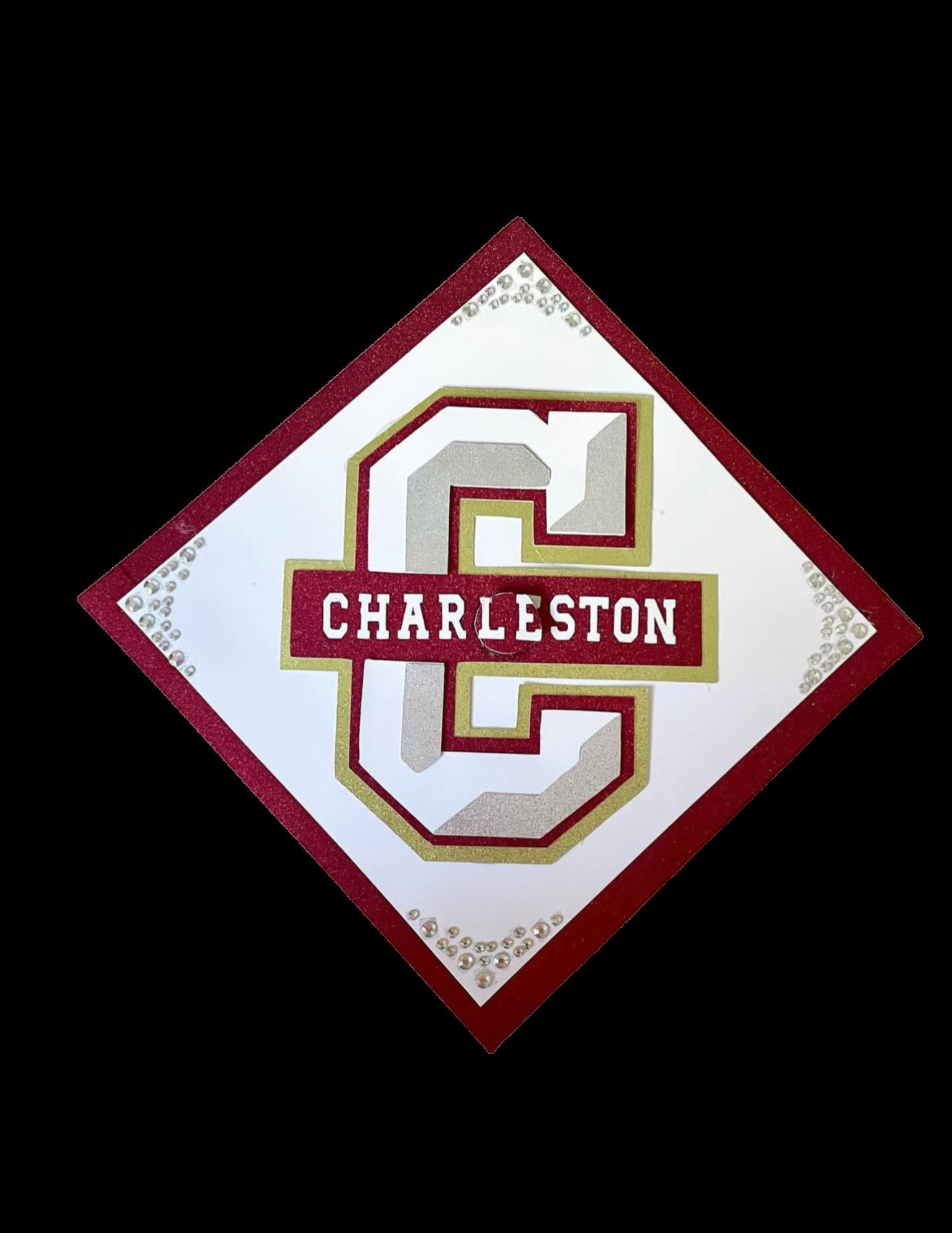
Egnal’s affinity for card-making quickly gained recognition from those around her. Her eighth-grade English teacher, Kelly Slaughter, supported Egnal from the beginning and still orders from her now. “She saw that I made cards and hired me to make 50—my first bulk order. From there, I made an Instagram account and just started selling them more often,” she said. “Ms. Slaughter really led to the start of my business. She believed in me and helped me believe in myself, which is how I got this all started.”
Being an entrepreneur is not without its challenges. Egnal’s creative process is incredibly time-consuming, with cards and graduation caps taking up to four hours apiece. Fulfilling an order—from design to refinement—is no simple task.
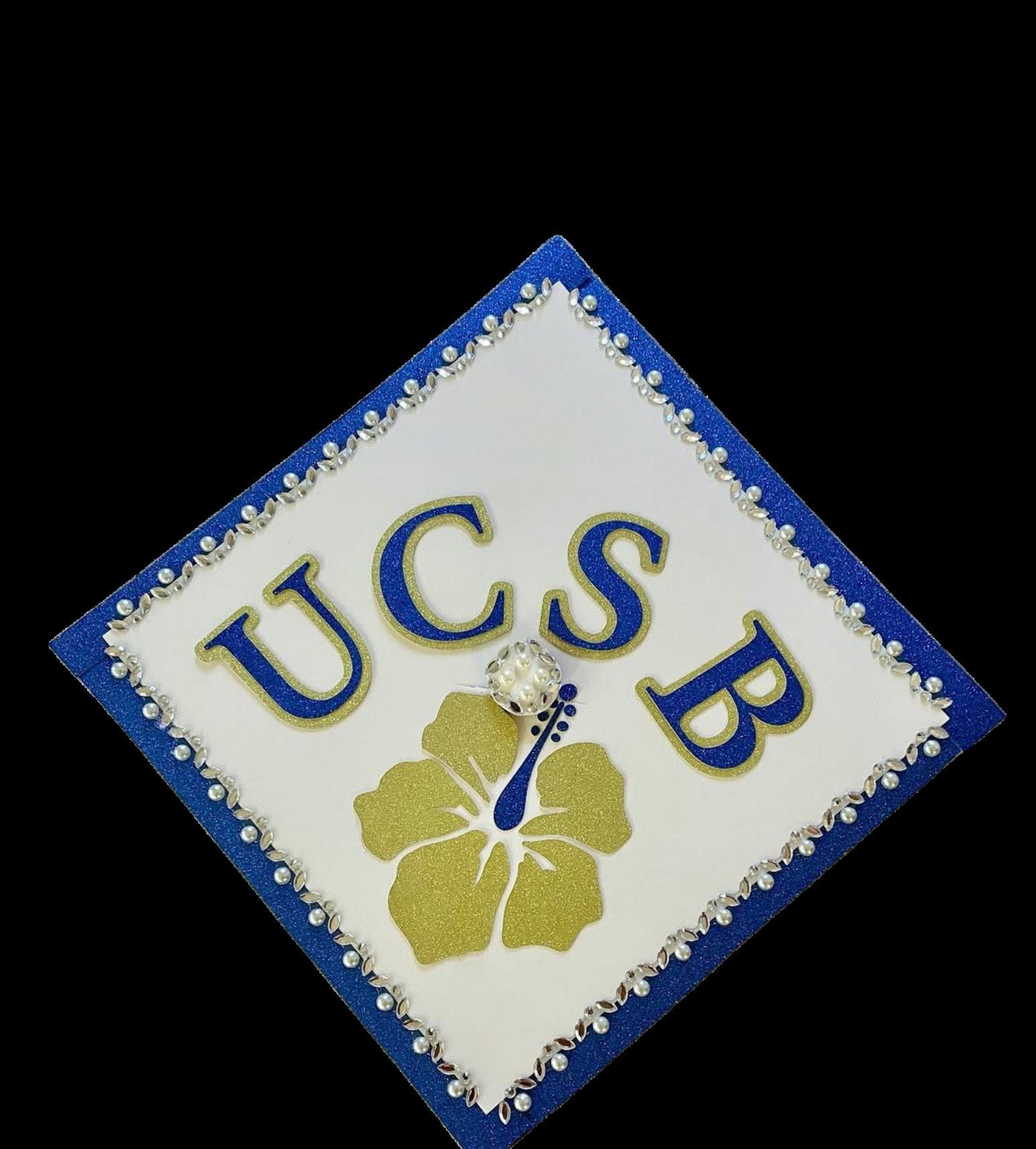
“My sophomore year, I was making a bulk order of either 50 or 100 cards. I saved it all to make over the course of one night, and I stayed up until two o’clock in the morning so that I could get it to the customer on time. That really taught me the importance of managing my time wisely,” Egnal said. “It feels really good to start a project and finish it all in one setting, but that’s not always the most re alistic with my busy schedule.”
As a perfectionist, Egnal maintains strict standards and never lets errors impact her work’s quality. “I always make sure I feel good about the work I’m putting out, re gardless of what the project is. If something doesn’t look good, I redo it and make it into something that I like and that I think the customer will appreciate,” she said.
Egnal is best known for her custom
graduation caps. “Freshman year, my Dance Team captain at the time asked me if I could help her make her grad cap because she had seen what I did with cards. I did, and I did it for a couple of other seniors that year as well. The next year, other seniors started asking me to make them, and it’s just grown from there,” Egnal explained.
As summer approaches and excitement builds for the class of 2025, Lainey’s Cards & Creations is already in full swing. In spare moments during the school day, Egnal can be found designing graduation caps on her laptop.
Graduation caps are Egnal’s favorite—and most rewarding—projects. “With cards, I don’t really get the reaction of the person receiving cards because it’s coming from someone else,” she said. “With graduation caps, I get to see the person’s face when they get it and how excited they are. It is really fulfilling.” Egnal is now creating a cap for herself, and she’ll proudly be wearing her own work on graduation day.
by Varsha Sripadham designed by Karen Martinez photos courtesy of Lainey Egnal and Varsha Sripadham


EIGHT SENIORS. ONE PROJECT. FOUR QUARTERS.

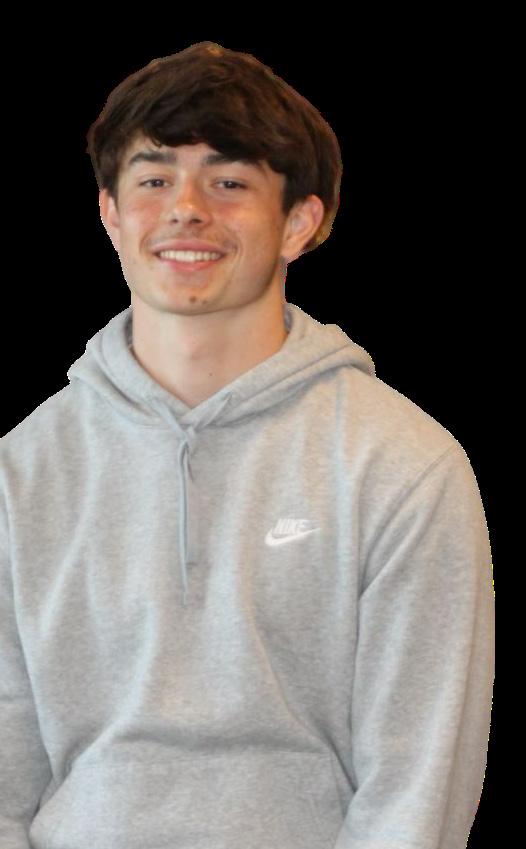





by Celine Chien and Tatiola Sobomehin
We interviewed eight seniors throughout their final year of high school and asked them the same questions each quarter.







ANGELEAH FAYETTE
What’s the best thing about senior year so far?
“The best thing is that I have really good teachers this year. I feel really lucky.”
PAUL WHELAN
What’s the best thing about senior year so far?
YANDEL HERNANDEZ
What’s your biggest goal for senior year?
OFA TAHAAFE
What’s the best thing about senior year so far?
JAYDEN DELAFUENTE
What’s the best thing, about senior year so far?
MATTEA HARRIS
What’s your biggest goal for senior year?
XANDER ESCHELMAN

LEXI CHUA
What’s the most important thing to you right now?
What words of advice would you share to your future self next quarter?
“Being able to walk around school and feel like you’re the top dog, even though you’re not. I feel more confidence in senior year, and I take that everywhere I go—just living that way is so fun.”
“I want to get out of my shell. I want to make as many friends as possible and to go past the limits that make me afraid to talk to people. I want to be social and someone that others look forward to meeting.”
“I would say probably my English class. Mr. Rosenberg is a really funny teacher, so I think he really keeps my day going. If I get tired, his energy lifts me up so I don’t go to sleep.”
“Winning our first football game against Bellarmine. I like the feeling of winning a game as a team, especially against Bellarmine, because we’ve lost to them before.”
“My biggest goal is to graduate and finish all my college applications. I also want to get all A’s in my classes. I just want to graduate and walk the stage already.”
“My faith and family. My faith is good to stay grounded when you’re doing well and to not get too cocky. And when you’re not going so good, it’s good to pick yourself up and always stay rooted in that.”
“Don’t forget why you’re working so hard. I feel like I often get distracted by things that seem really fun or random creative projects I want to do, and I forget what I’m really working for.”
“I feel like I’ve had a lot of events in October. I went to the football games, a wedding, a festival with my friends, and a concert. There was a whole era where I was going out every single weekend.”
“High school just isn’t as stressful anymore. Every year it would ramp up, and it felt like high school was the most important thing. But now high school is just like—oh, I go to school.”
“My biggest goal is to really be happy through every moment that comes. I want to always have a smile on my face, even during hard moments. We have to feel certain feelings—even the sad ones—because they shape who we are.”
“My friends. They’ve really made my senior year memorable. I look forward to coming to school because I have lots of people that I can talk to and make memories with. I can just go out to brunch or lunch knowing that they’re going to cheer me up.”
“The football season ending was really emotional because I like the team that we have right now. I played for two other teams, but I feel like I didn’t have a bond like I did with this one. It was really sad to know that I won’t be able to play with them again.”
“My biggest goal for senior year is just to have all my college stuff figured out—get my scholarships done and have a plan for where I’m going after high school.”
“I’ll stay with my same answer as last time: faith and family. I think those are just the most important things I try to keep as my main priorities, and hopefully nothing distracts from that.”
“I want to make sure that while I’m preparing for college, I don’t forget all the study skills I’ve learned this quarter. I know I’m going to go to college and will have to use them all over again.”
“I’ve gone to a lot more events this school year, and I’ve gotten closer with my friends.”
“The best thing is hanging out with my friends and having freedom.”
My biggest goal right now is to make it to the finals and win the CCS state championship. That’s something the whole team has really been focused on. We all want it badly, and I do too.”
“Meeting new people and meeting the whole M-A community. I came to M-A on the first day from Eastside, being so nervous, but as each day went on, my confidence boosted because the community and environment were so loving here.”
“I feel like the teachers know who the seniors are, so they don’t trip on us as much as they do on the younger students. Like, they just treat us differently––they’re more chill.”
“I want to be happier. I want to get back into my relationship with God, because I feel like I’ve drifted away from Him a little bit, and I’m disappointed in myself for that.”
“I think I’ll just keep my answer the same. My family, faith, and just being a positive person in the community and for the people around me.”
“The best thing about senior year so far is how close I’ve gotten to many people throughout the year that I wasn’t super close with before.”
“How relaxed my teachers are—the interaction between me and my teachers when I was a freshman used to be very formal. Now, I feel very connected to them, and that bond is something I really appreciate.”
“I want to keep my grades up because I feel like, towards the end, that’s when I begin to sort of get sloppy. I also want to keep trying to wake up early, because I feel like it’s helped me a lot. I’ve been able to work out and get a bunch of things done.”
“The best thing about senior year right now is the excitement that I have about graduating. I know that I’ve had a rough year, but as we are coming to the end of our senior year, it has made me realize that it was all worth it.”
“Prom night was one of the most memorable things so far.”
“One of my goals right now is to enjoy these last moments I have in high school with my friends, whether big or small, either now or over the summer. I also want to stack up my money before going off to college.”
“What I said for all the other ones is probably the boring answer, but I try to keep it consistent: my faith, family, improving in everything—school or football.”
“Keep preparing myself for the hard things that are coming in the future, without being too stressed about it.”
“Don’t forget all your friendships and everything you’ve learned throughout the years. Keep in contact with everyone and check in occasionally, because this was 17 years of your life––you can’t leave just leave it behind completely.”
Spiffy Pottery
Anew creative hub has emerged on the corner of Gilbert and Menalto Ave., bringing the joy of pottery to Menlo Park. Spiffy Pottery Studio is a welcoming pottery space for both beginner and experienced artists.
Owner Jeffrey Liang, who grew up in Taipei, Taiwan, began exploring pottery in 2018 as a student at the City College of San Francisco. “I had always been curious about pottery, but I had never been able to do it,” he said. “Since I started, I accidentally fell into the rabbit hole of it.”
Liang began to sell his own creations under the name Spiffy in 2022 and eventually opened Spiffy Pottery Studio this February.

The studio offers four-week classes for children as well as one-time workshops for kids, teens, and adults.
Each week has a different objective. For example, week two focuses on foundations and theories, while week three centers around trimming. “We also do practice hours, so besides the class hour, they can come in and practice and make whatever they want,” Liang said.
The studio caters to potters of all skill levels. “We inspire people and explain to them the fun of pottery and why it is so entertaining and easy to get addicted to.
That’s our goal,” Liang said.
Liang’s advice to anyone looking to start pottery is not to be afraid to fail or get dirty. “It is a challenge for some people to get used to failures. That’s how we learn, and that’s how we improve,” he said.
“Our specialty is to help people with high expectations of themselves. Part of our job is to comfort them and guide them to success.”
by Ivy Watrous photos courtesy of Ivy Watrous

Nestled along Fulton Place in Fremont, -ing Art Studio offers customers a cre ative journey to craft their own metal artwork and jewelry. The DIY studio, founded by friends Skylar Bao and Will Wang, offers jewelry-making classes and hosts gallery showcases.
Bao was born in Helong Jian, China. When she was 14 years old, she im migrated to the U.S. and settled in Fremont. Bao had to adjust to a new country and navigate her pursuit of a non-traditional career path: jewelry design.
At the end of 2021, Bao met Wang through a mutual friend. Both had extensive experience in the art community and were seeking a new entrepreneurial venture. As a result, the two began brainstorm ing the initial plans for the studio.
-ing opened in June 2023. The use of the suffix “-ing,” which is used with all progressive tense verbs, represents the pair’s hope to experience the present through creating art. “The past is the past, and no one knows the future. What you can only experience is the present. That’s why I want people to focus on the present moment,” Bao said.
Currently, -ing offers jewelry-making classes in a variety of styles and types of jewelry, including rings, bracelets, earrings, and necklaces.
Bao’s advice to aspiring immigrant business owners is to be optimistic about aspirations: “There are many possibilities. Don’t stop yourself or tell yourself no.”
by Eileen Liu
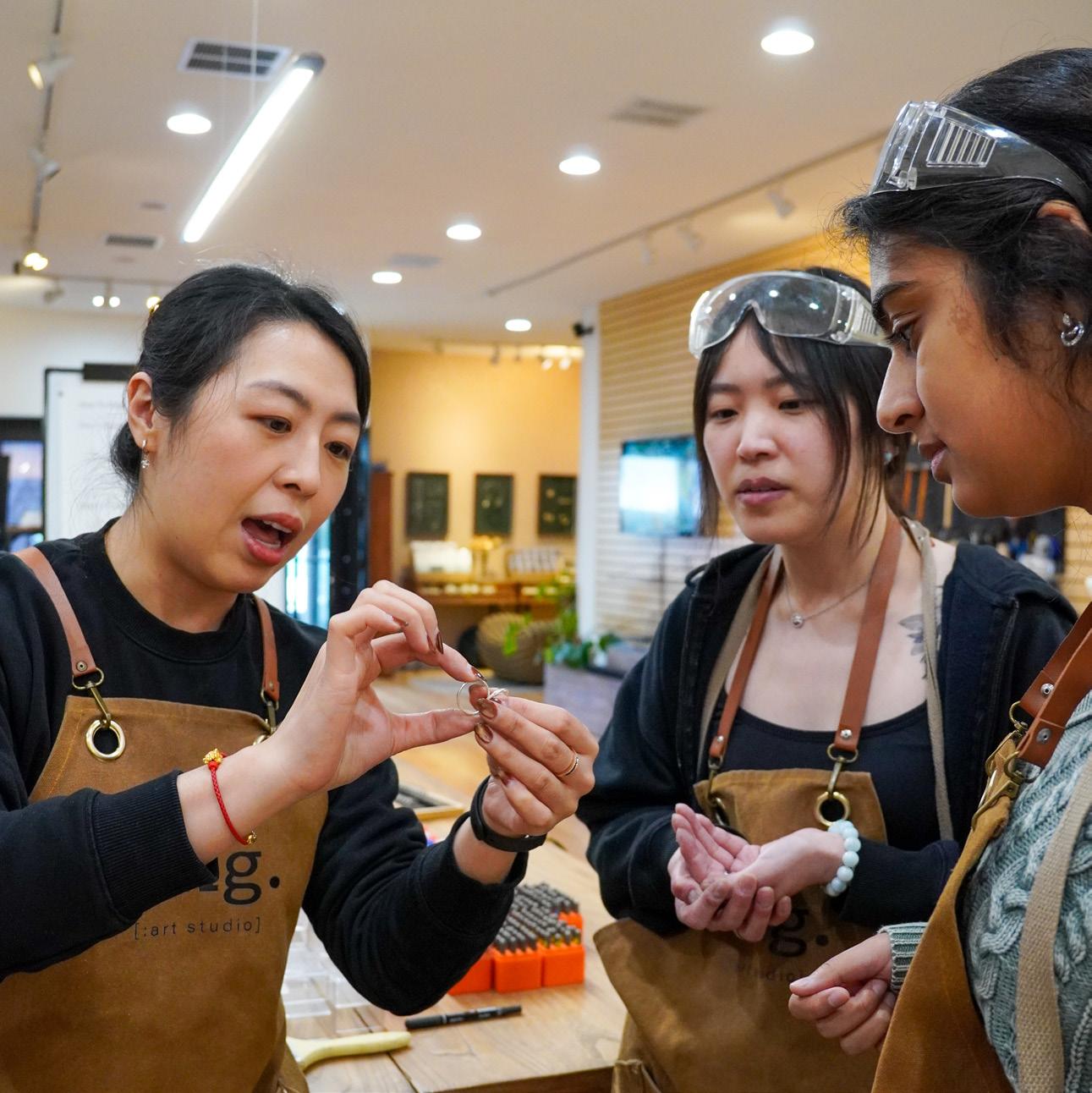
As you pass by 458 El Camino Real, hundreds of vibrant fabrics shine through glass windows. Next to gemstone-covered and patterned dresses, a sign reads “ViBha.”
Fashion designer Vinaya Gopisetti named her label after her pen name: ViBha. “While growing up, I loved art, and I used to do a lot of sketching, painting, coloring, and embroidery,” Gopisetti said.
Gopisetti earned a degree in Fashion Design from the Himas Institute of Fashion Technology school in Hyderabad, Telangana, India, and moved to the U.S. with her family in 2007. As she explored new job opportunities, Gopisetti noticed the lack of unique Indian clothing options in the Bay Area. “I’m not just targeting the Indian clientele. As a fashion designer, I had a clear picture in my mind of bringing Indian fashion to the West,” she said.
With the support of friends and family, ViBha’s doors opened in 2012.
Gopisetti participated in numerous fashion shows and charities to increase brand awareness. “It is a huge platform for any fashion designer to showcase their creativity. I was the only Indian designer shown for three years at the San Francisco Fashion Community Week,” Gopisetti said.
Owning a fashion label has not been all glitz and glamour. “When I am doing a fashion show, there are so many sleepless nights. You need to coordinate with multiple models, makeup artists, hair stylists, fashion choreographers, event venues, and other logistics,” Gopisetti said.
Gopisetti’s advice to immigrants is to find their passion and pursue it. “If you have a passion for any field, go for it. As for your business, give it time. No business will immediately see profits or fame. Be patient, give time, work hard, enjoy the process, and learn every day,” she said.
by Eileen Liu photos courtesy of Eileen Liu



Tandez Academy, located on Old Middlefield Way, is not your typical martial arts school. Since 2005, founder Adrian Tandez has trained over a thousand students using a blend of traditional martial arts and practical self-defense techniques.
In 1982, Tandez and his family immigrated from Manila, Philippines, to Chicago. After attending the University of Southern California, Tandez lived in Hollywood to pursue his dream of becoming an actor. During his time there, Tandez was mugged by two men who later tried to break into his apartment. This experience motivated him to learn Filipino martial arts to defend himself.
In the early 2000s, Tandez moved to the Bay Area and started his own business to help others defend themselves. “Traditional martial arts is too outdated, not practical, not efficient. For me, martial arts is about seeking the truth,” Tandez said.
Tandez Academy officially opened its doors in 2005. “I named the school Tandez Academy of Martial Arts to pay homage to my teacher Dan Inosanto. His school is called Inosanto Academy of Martial Arts, and I wanted to pattern my school after him,” Tandez said.
The academy offers a wide range of martial arts and defense styles. “Nowadays, people think martial arts is wearing a karate uniform and breaking boards,” Tandez said. “I instruct martial arts from different countries because I want people to understand it’s not just what you think it is.”
Tandez’s advice to aspiring immigrant business owners is to never give up on your goals and dreams: “No matter what, don’t give up your dreams, work hard, and keep going. Even if your goals seem impossible, don’t quit. If you quit, you’re giving up on yourself and the people who have gotten you to this point.”
by Eileen Liu designed by Eileen Liu photos courtesy of Eileen Liu


















Throughout my life, I never worried about my place in this country—until now. When I heard about President Donald Trump’s plan for the mass deportation of undocumented immigrants, I felt a wave of fear for myself and my family.
In that moment, my sense of security shifted. Even though I am a citizen, I worried for my undocumented loved ones who have worked hard to build a life here.
Trump is also making efforts to end birthright citizenship. The idea that I would have to prove my American identity to my own government is infuriating. I was born here. This is my home. I am American, and I shouldn’t have to defend that.
Even if the plan to end birthright citizenship never becomes law, immigration enforcement is already affecting millions of immigrant families. Many people have been forced to leave behind their homes, jobs, and loved ones, unsure if they will ever see them again. The fear of deportation is something I understand all too well.
Ever since my family migrated here, only a few of my loved ones have traveled back to Guatemala, and even then, it was only for brief visits. Most haven’t returned at all. Over the years, I’ve watched how the place that once held so much meaning for them slowly became a distant memory. They’ve built new lives here, learned a new language, embraced a different culture, and raised families of their own. With that, their sense of home shifted. Guatemala, with all its beauty and nostalgia, no longer feels like home to them.
I wonder what family gatherings would
be like if my loved ones were deported. The conversations and laughter that fill the room would be gone. Who would I talk to if my cousins weren’t there? Our Fourth of July celebration, when my entire family comes together to celebrate being American, would feel like a painful contradiction. How can we honor being American when our government tells us we don’t belong?
The American Dream is about working hard to achieve success and prosperity. My family has done just that. They came here to build better lives. Despite some of them being undocumented, they are hardworking, responsible, and the most big-hearted people you’ll meet. The thought of losing them and our family being torn apart is unbearable.
When my mom tried to renew her green card, she faced long lines and repeated denials. If legal residents struggle this much, how can undocumented immigrants have any hope?
Deportations don’t just remove individuals, they tear families apart, leave children without parents, and destroy communities. Many immigrants flee poverty, violence, and persecution, only to live in constant fear of being sent back to the dangers they risked everything to escape.
To those who have undocumented family members, know that you are not alone. Many of us share this fear.
I can’t imagine life without my family, and I refuse to stay silent while they live in terror. Our stories matter. We must stand together to protect those who make our lives whole.
written anonymously designed by
Miya Yu and Teagan Murphy
Alo largo de mi vida, nunca me preocupé por mi lugar en este país—hasta ahora. Cuando me enteré sobre el plan del presidente Donald Trump para la deportación masiva de inmigrantes indocumentados, sentí una ola de miedo por mí y mi familia. En ese momento, mi sentido de seguridad cambió. Aunque soy ciudadana de los Estados Unidos, de repente la lucha de mi familia se sintió personal. Me preocupaba por mis seres queridos indocumentados que han trabajado duro para crear sus vidas aquí.
Trump también está haciendo esfuerzos para acabar con el derecho de la ciudadanía por nacimiento. La idea de que tendría que justificar mi identidad estadounidense a mi propio gobierno es indignante. Nací aquí. Este es mi hogar. Soy estadounidense, y no debería tener que defenderlo.
Incluso si el plan para acabar con la ciudadanía por nacimiento nunca se convierte en ley, las autoridades de inmigración ya están afectando a millones de familias inmigrantes. Muchas personas han sido forzadas a dejar atrás sus hogares, trabajos y seres queridos sin saber si los volverán a ver. El miedo de la deportación es algo que entiendo demasiado bien.
Desde que mi familia emigró aquí, solo pocos de mis seres queridos han regresado a Guatemala, y aún así, fue solo para visitas breves. La mayoría no ha regresado. A lo largo de los años, he visto cómo el lugar que una vez significó tanto para ellos lentamente se ha convertido en un recuerdo lejano. Han construido nuevas vidas aquí, han aprendido un nuevo idioma, han adoptado una cultura diferente y han criado sus propias familias. Y con
eso, su sentido de hogar cambió. Guatemala, con toda su belleza y nostalgia, ya no se siente como un hogar para ellos—se siente como un lugar que solían conocer. Me pregunto cómo serían las reuniones familiares si mis seres queridos fueran deportados. Las conversaciones y risas que llenan la habitación se desaparecerían. ¿Con quién hablaría si mis primos no estuvieran allí? Nuestra celebración del Cuatro de Julio, cuando toda mi familia se reúne para celebrar ser estadounidense, se sentiría como una dolorosa contradicción. ¿Cómo podemos honrar ser estadounidenses cuando nuestro gobierno nos dice que no pertenecemos?
El sueño americano se trata de trabajar duro para lograr el éxito y la prosperidad. Mi familia ha hecho exactamente eso. Vinieron aquí para construir vidas mejores. Aunque algunos de ellos son indocumentados, son personas trabajadores, responsables y de gran corazón. La idea de perderlos y que nuestra familia sea separada es insoportable.
Cuando mi madre trató de renovar su tarjeta verde, se enfrentó a largas filas y negaciones repetidas. Tuvimos que viajar a San Francisco varias veces solo para resolver un problema simple. Si los residentes legales luchan tanto, ¿cómo pueden tener esperanza los inmigrantes indocumentados?
Las deportaciones no sólo remueven a personas, destruyen familias, dejan a los niños sin sus padres y dañan comunidades enteras. Muchos inmigrantes huyen de la pobreza, la violencia y la persecución, solo para vivir con el
miedo constante de ser devueltos a los mismos peligros que arriesgaron todo para escapar.
Si tienes familiares indocumentados, no estás solo. Muchos de nosotros compartimos este miedo.
Nuestras historias importan porque contienen el miedo de perder a las personas que amamos. No puedo imaginar la vida sin mi familia, y me niego a permanecer en silencio mientras que ellos viven en el terror. Tenemos que permanecer unidos para proteger a los que completan nuestras vidas.
escrito de forma anónima diseñada por Miya Yu y Teagan Murphy






















When I found out my freshman biology class would be dissecting a pig, I was appalled. Not only did it sound disgusting, it contradicted my values.
The methods of obtaining specimens are troubling, and the emotional impact on students is too often overlooked. With modern alternatives that are both more effective and cost-efficient, clinging to dissection is outdated and irresponsible. In high school, the potential psychological harms and animal cruelty involved in live dissections outweigh the benefits of brief hands-on learning experiences.
The fetal pigs and shelter-euthanized cats used at M-A come from Carolina Biological. In the ’90s, an ABC investigation found that one of Carolina Biological’s main suppliers was involved in legal trouble for animal mistreatment. The company claims to use more ethical suppliers now, but these allegations remain concerning.
Fetal pigs are removed from slaughtered pregnant sows, making them a byproduct of the pork industry. “The ethics of slaughtering a pregnant pig can be an alternate discussion over the way our industrial farming practices have evolved,” Biology teacher Mark Helfenberger said.
Even taking species that are plentiful from their natural habitat can be disruptive to surrounding ecosystems. Marine Biology teacher Erika Shepard recently decided to phase out dissections in her classroom for this very reason. “Humans are negatively impacting the ocean as a whole, and there is no way to tell if the harvesting of plentiful species is not damaging other, more unique species,” she said.
Despite ethical concerns, many teachers believe dissections are an important part of science curricula. “I am aiming for so much more than student retention and repetition of names and functions of internal organs,”

Helfenberger said. “I am offering them opportunities they will not have the chance to do
again, unless they choose to pursue a career in this field later in life.”
During my freshman year pig dissection, I witnessed people laughing and posting pictures of the pig as online entertainment. Students in AP Biology dissected cats and had similar experiences. “People were making fun of the cat, saying it was fat,” junior Millo Skhiri said.
Furthermore, early exposure to anatomy doesn’t have to come at the cost of animal lives. With modern technology, there are plenty of alternatives. This includes interactive virtual models, paper dissections, and 3D models. These alternatives are just as effective, if not more. Studies show that 30% of students learn better with digital and 3D models, while 60% achieve the same results as dissecting an animal. Only 10% learn less effectively.
“If you had asked me 10 years ago, I’d say real animals are much better. But now, the alternatives are coming up really fast,” Dr. James Murray, a biology professor at California State University East Bay, said. “These alternatives are adequate for a high school level and possibly for a college level as well.”
Students who aren’t interested in dissections can still have successful scientific careers. “There are so many aspects of biology that do not require looking at the structures and functions within a body. You could study climate change impacts, population dynamics, genetics, ecology, and so much more,” Shepard said.
Some students avoid certain science classes due to their inclusion of dissections. “I’m not taking AP Biology even though I would love to take the class, specifically because I do not want to do the dissection. If the dissection didn’t exist, I would almost definitely be taking it,” sophomore Ava Glass said.
By pushing students away from taking cer tain science courses, dissections are effectively pushing people away from science as a whole. And that’s a problem—science drives innova tion, shapes public health, and helps us con front global challenges like global warming, disease, and food insecurity.
We should be opening doors for more stu dents to enter the field, not scaring them away with outdated practices that don’t reflect the full scope of what science can be. It is time for schools to evolve past the practice of sacrific ing animals and embrace the future of ethical science education.
by Ivy Watrous

Dissections may be a moral gray area, but they are important to biology classes. As someone who dissected a fetal pig in Biology and a cat in AP Biology, I’ve learned far more through those experiences than I ever could have through textbooks.
Dissections are some of the most informative and interesting parts of science classes. Having a physical representation of anatomy helps students understand the spacing of organs and have a tactile experience with the class material.
For many students, including myself, the monotony of taking notes every day or listening to lectures is exhausting and boring.
“The dissection made me learn better because you could see it and feel it, whereas in a diagram, it’s not as clear,” junior AP Biology student Adam Ho said.
In a study that assessed student knowledge of the anatomy of fish and rats, students who used both plastic anatomical models and cadavers showed the most improvement, while students who only used the anatomical models showed the least improvement by a significant margin.
Studies like these can unfortunately be misinterpreted and twisted by organizations like PETA, an animal rights group. Study summaries published by anti-dissection groups only include that the students who used models had higher test scores, when in reality, dissections showed larger improvement in scores.
Arguments against dissections typically revolve around their supposed cruelty, including killing animals exclusively for dissection, disregard for life, or inhumane living conditions, but in reality, those claims are largely unfounded.
Dissections use animals that would otherwise be disposed of. Fetal pigs, for example, are byproducts of the meat industry. They are extracted from the sow in utero, while the sow is used to make meat. Companies like Carolina Biological, from whom M-A purchases most of their specimens, purchase these fetal pigs, preserve them, and then sell them to schools for dissections. These animals would not be alive regardless of the dissection.
When we were preparing for the dissection, my AP Biology teacher emphasized that respect for the animals was required. We were only allowed to take photos with explicit permission and had to promise that they were only used for the purpose of studying. If students chose to
act in disrespectful ways around the animals, they were warned that there would be severe consequenc es, including a refer ral to the AVP office.
“I was afraid of the cat at first, but after learning its anatomy and truly under standing the animal, you almost feel like you are appreciating their existence more because you understand their nature a bit better,” se nior AP Biology student Ayla Karadogan said.
It is understandable that some students don’t want to partake in dissections. Whether they object to dissections for moral reasons, religious restrictions, or adverse medical reactions like fainting, students should have the option to opt out—and they do. According to California Education Code 32255, all students in grades K-12 have the right to request an alternative to an animal dissection that is of comparable time and effort. Similar laws exist in 21 other states and the District of Columbia.

“I tell my students weeks ahead of time that the dissection is coming to give them time to prepare and decide if they wish to be an active participant or not,” Biology teacher Mark Helfenberger said. “If not, they are expected to be present and assist their lab group by reading instructions, writing in the paper of students dissecting, cleaning up tools, or wiping down tables if they are comfortable.”

Some students’ opposition to dissecting animals shouldn’t mean that everyone has to miss out on the valuable opportunity to gain surgical experience, effectively learn about anatomy, and spark interest in the field of biology.
“I feel like my knowledge before the dissections was more superficial than afterward. The dissections really helped me gain a deeper understanding of different bodily organs and their functions,” junior AP Biology and Human Biology student Lily Pellican said.
by Alli Schindler
designed by Ivy Watrous illustrated by Abby Medin
OR NEEDED?
What do they mean for M-A students?
The District ratified a provision to revert to President Donald Trump’s 2020 Title IX policies for all sex discrimination procedures regarding students and staff, undoing former President Joe Biden’s 2024 procedures, on Feb. 11.
Trump’s 2020 Final Rule had a narrow view of sexual ha rassment and lowered expectations for handling sexual mis conduct in schools. The policies, created by then-Education Secretary Betsy DeVos, required cross-examinations from both parties during investigations and “clear and convincing evidence” instead of a “preponderance of evidence,” leading to complaints that they favored the accused.
The Biden administration changed Trump’s policy to broad en what was considered sexual harassment. The 2024 Final Rule included discrimination based on sexual orientation, gender orientation, sexual characteristics, and sexual stereo types.
But, with Trump back in office, the old policies have been reinstated for high schools nationwide. A federal judge in Kentucky struck down Biden’s policy on Jan. 9. The Depart ment of Education sent out a letter on Feb. 4 outlining the repeal of the 2024 Final Rule and mandating that all ongo ing Title IX investigations be handled under the 2020 regu lations.
“Under Biden’s Title IX policies, schools had an obligation to proactively change the school culture, to go out and try to stop sexual assault,” Villanova Law Professor Ann Juliano explained. “The Trump administration has made it clear that schools just have to be reactive.”
Reports are now limited to clear cases of sexual assault that occur on-campus or in locations where the school ex ercises “substantial control” over both the respondent and the accused.
Even under Biden’s Title IX regulations, students experi enced difficulties with M-A’s sexual assault reporting system. “It really reigns in what schools need to do to try and stop sexual assault. So, it can completely change the atmosphere of schools,” Juliano added.
The Title IX definition of sexual harassment has also shrunk to only apply to situations where it is considered “so severe, pervasive, and objectively offensive that it denies its victims equal access to education.”
Jarrett Dooley, one of the District’s Title IX Coordinators, explained that the District will continue to “provide consistent training to its Title IX Coordinators and those involved in the Title IX grievance procedure.
In addition to repealing Biden’s 2024 Final Rule, Trump signed an executive order on Feb. 5 prohibiting transgender women from competing in women’s sports, repealing Biden’s protections for LGBTQ students.
Trump’s order remains under consideration by the California Interscholastic Federation, which will continue to follow state law instead. These laws allow athletes to compete on sports teams that align with their gender identity.
“California protects based on gender identity expression, so if that is held to be in conflict with federal law policy, it is unclear how schools will handle this issue,” Juliano said.
“The changes to Title IX do not affect our goals to maintain a safe and healthy campus that is supportive of all our students, they only affect what policy is used to process complaints and what the Title IX procedure looks like,” Dooley said.
by Isabel Habibi designed by Jovi Wong


*The name of this interviewee is a pseudonym to protect their confidentiality.
Nalmost, instead,” she said.




early 8% of high schoolers—over 1.2 million students—used e-cigarettes in 2024. Within this group is an overlooked subset: those trying to quit.
Whether motivated by a New Year’s resolution or the struggle to catch a breath at sports practice, many teenagers attempt to end their addictions. But nicotine is notoriously addictive, and an overwhelming majority of students interviewed reported failing their attempts to quit.
Sally’s* journey is one of the few success stories. She started vaping as a freshman and quit in her junior year. “Honestly, it was really embarrassing how all my friends were addicted, and I wanted to prove to myself that I could stop,” she said.
Her method? Quitting cold-turkey. “It started when I went on vacation and didn’t bring it with me. Then I was like, you know what, I’ll just keep going,” she explained.
Her advice for those trying to do the same is to set small, realistic goals you can fully commit to instead of making promises you can’t keep. “I think it’s embarrassing to throw your vape out your window and then go buy one. You need to make a deal with yourself and actually quit,” she said.
For Abby*, quitting has been a rocky journey. She started vaping as a sophomore but made a New Year’s resolution to quit the following year. “When I run during practice, my lungs hurt so badly, and I know it’s so bad for me. It’s a horrible habit, and I just don’t know why I even do it,” she explained.
She attempted to quit four times, each try lasting around 10 days. For Abby, quitting is a social challenge. “I think the hardest part about quitting is that my friends aren’t,” she said. “It’s still so accessible. If you want to quit, make sure not to surround yourself with it.”
One helpful strategy has been replacing vaping with eating candy. “I like sour candy a lot because instead of reaching for a vape, I’ll have a piece of candy, like a treat
Though Kevin* first picked up a vape this year, he’s already unsuccessfully tried to quit. “I only started because I had held off for so long despite my friends doing it, so I felt as though I could reward myself and buy one,” he explained.
When Kevin finally decided to quit, he began by drowning his vape in a glass of water. Though he successfully gave up using e-cigarettes, he continued to rely on nicotine. Kevin got his fix through ZYN pouches.
Despite personal struggles, Kevin advises others to quit by breaking out of the repetitive hand-to-mouth motion. “Try nicotine gum or ZYNs first to get your fix in another way without needing to hit the vape itself,” he said. “If you observe those around you and how many times a day they need to hit theirs, it puts how much you’re really doing it into perspective.”
Sarah* is another example of a success story. She began vaping in eighth grade, influenced by peer pressure and a desire to fit in. By December of her senior year, she fulfilled her resolution to quit.
“I first stopped owning my own and would use other people’s,” she explained. Like many others, Sarah’s wake-up call came during sports practices where she found it increasingly difficult to breathe.
“After a sort of scary season, I thought, ‘Why am I still doing this?’” she said. “I’m about to go to college, and I definitely don’t want to have this problem there either.”
Sarah’s advice to others trying to quit may seem peculiar, but it just might do the trick. “I started watching videos about vaping, like the nitty gritty health effects and what your lungs would begin to look like, which really grossed me out,” she said. She also suggests talking to others who have quit.
While it is a strenuous journey, quitting vaping is possible. Whether you switch to ZYNs or replace a vape with candy, small steps are still steps.
by Huraman Orujov designed by Parmis Hoghooghi photo courtesy of Apollo Ecigs

The annual dance show featured 31 performances by the M-A Dance Team and local dance studio, Studio650. Senior trio and self-choreographed group performances composed the majority of the program. “I love the senior trios because it’s a chance for us to bring out our silly sides and make a fool out of ourselves onstage with crazy costumes and fun songs,” senior captain Zoe Fong said. As the show came to a close, both varsity and JV teams performed the long-awaited partner dance, where dancers performed with their non-dancer counterparts.
After an emotional senior slideshow and awards, Coach Kate Lynn Roberts an

he spring musiHadestown Teen Edition, ran for two weekends in March, bringing a new life to the Tony-winning Broadway show. The musical follows the Greek myth of Orpheus and Eurydice with New Orleans jazz and folk music played by a live student band. The production also included hightech elements of a descending platform and a moving turntable, which represented life’s cy cles. “The show has a theme of perseverance. Even if it didn’t work out this time, and maybe it won’t work out the next time, just keep trying,” junior Kealy Bryman, who played Eurydice, explained. Hadestown was a hit for M-A drama, filling the Performing Arts Center for six shows in a row.



with lyrics based on the book Invisible Man, 17 years ago. This year, highlights included parodies of “HOT TO GO!” by Chappell Roan and “Burn” from Hamilton. The winning team parodied
The M-A jazz ensemble travelled to Hono lulu, Hawaii for their annual jazz festival during Easter weekend. The band head lined a show at the prestigious Blue Note Ha waii, one of the top jazz clubs in the country, with the Mike Lewis Big Band. The band also participated in a high school jazz festival at Waipahu High School. “The trip was a great experience because it was a professional setting where we could improve our playing under pressure,” senior saxo phonist Sacha Deb said. In their free time, the band relaxed on the beach and visited the Pearl Har bor and USS Arizona monuments.


Orchestra students traveled to Chicago in April for the World Strides Festival of Gold, an invi tational concert showcasing top-performing ensembles from across the nation. Over the course of four days, students engaged in individual ensem ble clinics, explored the city, and received critiques from world-class adjudicators and conductors. After a performance at the renowned Chicago Symphony Center, the orchestra received a superior score of 90 out of 100. The event culminated in the encore concert, where top-scoring ensembles got one last memorable performance and special recognition. “The trip let us bond a lot outside of music, which is really fun,” senior violinist Lexi Chua said.





































“The first couple of years as an administrator are really tough and overwhelming. You’re thinking every week, ‘I can’t do this anymore. I can’t wait until the school year is over’,” former M-A Instructional Vice Principal Steve Lippi said.
Over the past 10 years, M-A has welcomed 14 new administrators. Of those 14, only four still work at M-A.
Carlmont High School, on the other hand, has had the same administrative vice principals since 2015. Woodside High School and Sequoia High School have had the same AVPs since 2017.
M-A stands out as the only school in the Sequoia Union High School District with such frequent turnover. Administrators leave M-A for different reasons: some are promoted, some retire, and some are overwhelmed by the role’s difficulty.
Being a high school administrator is challenging at any school, but M-A’s unique demographics and intensity create specific demands that contribute to its high turnover rates.
Occasional turnover is necessary and beneficial: new administrators bring new ideas for school improvement. Frequent turnover, however, makes it difficult for an administrative team to collaborate efficiently and help teachers and students.
Our District must provide more formal support for new administrators to improve retention, allowing them to grow and create meaningful change.
Being a high school administrator isn’t easy. The position requires working long hours, facing stressful environments, and balancing the concerns of students, parents, and the District. All of this makes it an intense and tiresome job that requires constant vigilance.
To better understand these challenges, the M-A Chronicle interviewed 12 previous and current District administrators,
nine of whom have worked at M-A.
Administrative roles are difficult because of their significant time commitment outside of school hours. After-school events, sports games, and meetings can keep administrators out of the house three to four nights a week.
“I would never do this job if I had small kids because it disproportionately puts a lot of pressure on your spouse,” eight-year Woodside AVP Chuck Velschow said.
Administrators are also responsible if something goes awry at supervised events. “Every time there’s an event on campus, administrators are carrying this concern of, ‘This better go okay. I hope this is safe.’ You constantly feel that, and it’s exhausting,” M-A principal Karl Losekoot said.
On top of their daily tasks, administrators deal with unpredictable student conflicts and parent complaints. A teacher can send a conflict to an administrator, but an administrator has no one to call to resolve an issue for them.
ly prepare new administrators for their roles.
“There’s no training for a lot of what we do except for learning by trial,” former AVP Nicholas Muys said. “I literally moved into my office, and I had a Title IX case—it was one of the first things I dealt with. I had no idea what the protocols were for a Title IX investigation, and I had a binder, but no one had really gone through the process with me.”
High administrative turnover rates are a national issue. The average principal tenure in the U.S. is four years, according to a 2019 study. In California, principals typically serve for even shorter periods, with nearly 25% leaving their schools each year. M-A’s retention rates may not stand out nationally, but they’re a major outlier within our District, indicating that M-A poses distinct challenges for its administrators.
“I would never do this job if I had small kids because it disproportionately puts a lot of pressure on your spouse.”
- Woodside AVP Chuck Velschow
“You can walk into your office, and somebody will walk through your door. You’ll get a phone call, and you have to react quickly to what’s going on,” Lippi said. “There could be some student discipline thing you’re dealing with at 4 p.m., and that’s going to keep you on campus for a while.”
“Even when I’m at home, I’m still working,” M-A AVP Amy Hanson said. “If there’s an emergency—like a suicide risk through the ‘Say Something’ line— we get called, as we should. But that call could come at two o’clock in the morning. If you do that long enough, it can affect your marriage, your family life, things like that.”
Even worse, administrative credential programs often lack sufficient training for real-life scenarios, failing to adequate-
While major time commitments and unexpected situations are inherent to an administrator’s job, M-A’s environment intensifies these challenges, which can lead to burnout.
Even though M-A has one more AVP than every other District school, administrators still feel spread too thin. “At M-A, it sometimes felt like 24/7 with all the activities, events, and sports teams,” TIDE principal Simone Rick-Kennel said. Kennel worked at M-A for 13 years in all three administrative roles, including principal. She then moved to TIDE, a newly opened District high school with around 200 stu-
dents, in 2021.
M-A’s diverse student population from Atherton, Menlo Park, East Palo Alto, and Redwood City requires administrators to respond to a vast range of needs. “We have a very diverse student body, not only racially but also socioeconomically, and those gaps are sometimes really hard to bridge on our campus and in our classrooms,” M-A AVP Elaine Rivera-Rios said.
“I may have one parent who wants to talk to me because their kid is super stressed about meeting a deadline, and then there are the other kids where it’s more like, ‘How do I encourage you to get to class?’” Rios added.
National data shows that principals in schools serving ethnically and socioeconomically diverse populations are 60-70% more likely to leave.
“M-A can feel like a really intense place to work because we genuinely want to serve at another level and operate with excellence all the time,” Rios said. “Some people may fall short of it.”
M-A’s high administrative turnover is nearly all within the AVP office. While all three current AVPs are in their first or second year, IVP Emily Rigotti has been in her role since 2021, and Losekoot has been an M-A administrator since 2011. IVPs and principals undoubtedly face heavy workloads and stress, but AVP positions can be particularly unsustainable due to their focus on discipline.
“When you’re in an AVP position at
M-A, you’re putting out a lot of fires, and your job becomes more about being a disciplinarian,” former M-A AVP JC Farr said. “For some people, that isn’t what they got into education for.”
“If you are in charge of discipline for 10 years, you get sick of another vape or another fight. It can be draining,” Hanson said.
“People expect you to change the behavior of kids, and that can wear on an administrator because your kids misbehave due to many factors, and some may be out of your direct control,” Farr said. External determinants like socioeconomic status and living circumstances can directly affect a student’s behavior at school.
“Your performance is based on the kids and how they are responding, and it becomes a reflection of your leadership,” Farr added.
“We’re not good at supporting people in what is a really difficult job, because once you’re on the ground, everything comes at you fast and furious. Especially in the AVP role, in the disciplinary area, there is no time for reflection,” M-A English Department Chair Liane Strub said. Strub, who has worked at M-A for 30 years, formerly coordinated with administrators and mentored teachers as a Peer Assistance and Review coach.
Stress isn’t always the main reason AVPs leave: the AVP role is often considered an entry-level administrative job, so many are hired elsewhere for higher po-
sitions.
“If you’re doing a good job here—such a diverse school where you’re serving such different populations—it makes you an appealing candidate for other positions,” Losekoot explained. “But maybe if administrators had a better work-life balance at M-A, they wouldn’t take that job and they’d stay.”
Farr left in 2016 to become principal at Tamalpais High School, AVP Janelle Bugarini left in 2019 to become the English Learners coordinator at the District, AVP Tara Charles left in 2023 to become an IVP at Sequoia High School, and AVP Stephen Emmi left in 2023 to become a wellness coordinator at the District.
Muys left M-A in 2024 to teach English at Middle College. “I miss teaching, and I miss using that part of my brain,” he said in an interview a few weeks before his last day at M-A. “But I’m also tired. This is tiring work.”
The past few years have been even more tiring than usual: as schools returned to in-person learning after the pandemic, administrators were forced to either revive past operating systems or create new ones. “When we got back, we had to reinvent all of these processes to figure out how to make things run efficiently. That was a lot of work, and it continues to be a lot of work,” M-A librarian and former PAR coach Catherine Burton-Tillson said. Burton-Tillson has worked at M-A for 26 years.
Since the pandemic, M-A’s AVP turn-
Since the pandemic, M-A’s AVP turnover rate has surged, with annual departures becoming standard. This constant movement creates instability, where turnover leads to more turnover.
M-A has also found itself in numerous public controversies over the past few years, far more than the average high school or other District sites. Administrators are often named in lawsuits and are responsible for communicating with staff, parents, and outside organizations if issues escalate.
In the past three years alone, M-A administrators faced heated conflicts over detracking, lawsuits after an altercation between a student and police, and public records requests and lawsuits alleging failure to protect students from antisemitism after a controversial Ethnic Studies presentation that made national news.
Dealing with lawsuits and conflicts is an inherent part of being a high school administrator, but its abnormal frequency at M-A puts extra pressure on administrators.
Occasional administrative turnover isn’t a problem. In fact, bringing in new perspectives can be helpful. But for fresh ideas to have positive impacts, new administrators must have the chance to collaborate with more experienced ones.
“What helps is having new perspectives and people who have been around for a while and have institutional knowledge,” 10-year Woodside AVP Wendy Porter said. “You can remember a lot of what’s happened over the course of the school’s history, and that helps with understanding how the community has developed, changed, or remained the same.”
When turnover is frequent, though, problems begin to outweigh benefits.
“When you start with someone new, there’s onboarding that takes some time. The impact might be that you’re spending more time learning the system as opposed to growing the system for the better,” Losekoot said.
The longer a professional team of any sort has worked together, the more they are able to solidify individual roles that complement each other without overlapping or leaving gaps.
In the 2023-24 school year, M-A AVP Jessica Magallanes abruptly left M-A after just one semester. After a few months of having just two AVPs, M-A hired Jonathan Ho, who served as an interim AVP during the final quarter of the school year. “That transition of having three AVPs, then having two, and then Mr. Ho—adjusting to all of those changes
and taking on different responsibilities that I was not initially assigned was challenging,” Hanson, who was in her first year as an AVP, said.
sequences to give.’ So, truthfully, it is difficult to have turnover, specifically in the AVP office,” Hanson said.
“Administrators will tell staff, ‘This is how we do attendance,’ or ‘This is how we do behavior referrals,’ and then, when there’s turnover, you get a new person who operates in a different way, and you have to learn that all again.”
- Librarian and Former PAR coach Catherine Burton-Tillson
Hanson came to M-A from Woodside, where she taught Spanish, to become an AVP. She recently announced she will return to Woodside next school year to serve as an AVP.
Having long-term administrators improves connections with families and carves clearer roles for each staff member. “People like consistency,” Hanson said. “When there are new people, there’s kind of a relearning process for students, parents, and community members.”
The vast majority of students don’t regularly interact with administrators. But, for the small portion who may have behavioral challenges and visit the AVP office frequently, maintaining a strong bond with an administrator leads to more personalized and effective solutions.
“If a student ends up in the office because they’ve been in a fight, having an earlier relationship with that AVP is going to make it possible to have a constructive conversation,” Strub said. “If you start as a freshman and you forge a relationship with an administrator, and then he’s gone when you’re a junior, you will feel that loss.”
This continuity is also important for teachers because administrators serve as the bridge between staff, parents, and the District. Teachers need to be able to trust that administrators will stand up for them, especially in the face of conflict. “A teacher might be called into the principal’s office about a call from a parent. When you’re at that point where you’re meeting with the parents, you really need to know that the principal is going to stand with you,” Strub said.
Administrative turnover also destabilizes a resource that teachers should be able to depend on—their supervisors. “Administrators will tell staff, ‘This is how we do attendance,’ or ‘This is how we do behavior referrals,’ and then, when there’s turnover, you get a new person who operates in a different way, and you have to learn that all again,” Burton-Tillson said.
“In my first semester, there was always something new that was coming up. And then finally, during the second semester, I was like, ‘Okay, I’ve dealt with something like this before. I know what kind of con-
To improve administrative retention, M-A and the District must implement better mentorship programs for new administrators and provide more spaces for them to share experiences and best practices.
For the past three years, the District has tried a program that pairs administrators with a coach to meet with and ask for guidance.
While this attempt to support new administrators is a step in the right direction, Rios said the resource hasn’t been particularly helpful due to her assigned mentor’s lack of relevant experience. Her mentor worked at a small elementary school and therefore didn’t have much helpful advice for a large, diverse high school like M-A.
The District should find mentors who have worked at M-A or one of its feeder schools to provide more useful guidance to M-A administrators.
After his 16-year IVP tenure, Lippi stayed at M-A as a math teacher for one year to mentor Losekoot, his successor. “It wasn’t that he needed a lot of help, but I wanted to be there and talk through situations with him,” Lippi said.
The District should also create more formal opportunities for administrators to discuss their work. “We meet monthly as AVPs, but there’s no forum for us to just talk about how it’s going and how we’re doing, at least not in any structured way, which would be helpful,” Muys said.
More organized forums would not only be beneficial for individual administrators’ well-being but also for the group as a whole, helping them communicate and work better as a team.
“When I was a new principal, I had the opportunity to be part of the Stanford Principal Fellows program. We were a group of principals from across the Bay Area who met monthly to support one another and share best practices. That kind of network made a huge difference,” Kennel said.
Hiring administrators from within M-A’s staff may also improve retention.
When new administrators are already familiar with M-A, they only have to adjust to a new job, not a new environment.
“If you come from inside the school, there’s a level of comfort with the school and the staff. You’re probably somewhat committed to this community, and that might aid in retention and help with a sense of, ‘I’m going to work through this because this is my community,’” Losekoot said.
“I didn’t have to acclimate to the campus and figure out who’s who, what’s what, and where to go,” Rios, who worked at M-A for over seven years before becoming an administrator, said. “It was nice that I just had to figure out how to do my role. When you have somebody coming from outside M-A, it’s different.”
Muys also proposed adjusting what is
taught in administrative credential programs to reflect the real experiences administrators face, like managing teams of classified employees and handling searches.
“My credential program focused a lot on thinking about things through an equity lens and leadership as a concept. That’s all important, but there are some nuts and bolts that would have been helpful to have some practical experience with before I jumped in,” Muys said.
The District should also devote more time to preparing new administrators, as credential programs are broad and every school district is unique. District administrators attend a one-day meeting over the summer to review policies, but this isn’t sufficient to fully acclimate them to the intense environment of their job. Dedi-
“How do we as a culture, as a school, set up systems that don’t wear out our staff? What are the systems that allow someone to have a work-life balance? That’s probably something we can improve on.”
- M-A Principal Karl Losekoot
cating more time to understanding their daily roles could help administrators start with more confidence. While true experience can only come with time, in such an intense environment, increased onboarding is necessary to better transition new administrators into their roles.
“How do we as a culture, as a school, set up systems that don’t wear out our staff? What are the systems that allow someone to have a work-life balance? That’s probably something we can improve on,” Losekoot said.
Faced with abnormal rates of conflict and a community with diverse needs, M-A administrators are in a uniquely stressful position that requires additional support. Our administrators deserve to work at a school where they feel adequately prepared for the challenges they face, and students and teachers deserve to go to a school where their leaders are set up to support them.
“If our educators, our teachers, our staff, and our administrators are happy, then our students are happy too,” Kennel said.
by the M-A Chronicle Editorial Board Celine Chien and Ben Siegel were the lead authors of this article. designed by Ben Siegel illustrations courtesy of Isabel Habibi and Alessandra Hartwig
As the head administrator, the principal oversees the school’s operations, safety, student learning, and staff management.
The Instructional Vice Principal assists with curriculum development, helps with teacher support services, enhances the quality of instructional material for students, and oversees the guidance department. The IVP is a singular position directly below the principal.
The Assistant Vice Principals work below the IVP and are open to multiple people. AVPs are responsible for maintaining a safe and orderly school environment as well as student discipline and attendance.
by Allegra Hoddie and Varsha Sripadham designed by Aliyah Chowdhary-Fitton
Celine Chien, Editor-in-chief

Celine designed a mural at M-A in honor of the inaugural Ethnic Studies class in 2022!
“When I first joined journalism, I was kind of shy. As I’ve gotten to know people and embraced leadership in journalism, I’ve made some of my closest friends through this program.”
“Journalism surprised me in a lot of good ways. I didn’t think that people would be able to respond with such thorough answers and open themselves up to me. It gave me a lot of crucial leadership skills.”
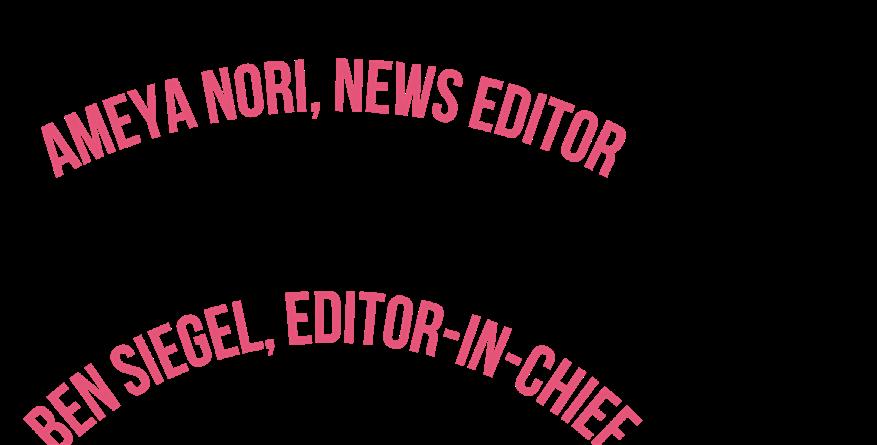

“I’m really going to miss the entire Editorial Board when I go to college. It’ll be pretty bittersweet when I realize that I won’t be able to contribute to the publication.”

Ben has been a dedicated member of M-A’s theater program. He’s acted, directed, and more!

Celeste has written over 20 articles for the Bears Doing Big Things column!
Ameya was first interviewed by the M-A Chronicle in 8th grade!

Tessa Ellingson, sports editor
“I cover such a variety of topics as Culture Editor. It’s been an ongoing conversation on how we figure out what we want to cover, because it can be such an ambiguous category.”

Lindsay park, events editor
Lindsay played oboe in M-A orchestra and outside of school!
Tessa created the master for three Marks in a row, which no one else has ever done!
“It’s really special that I know everything that’s going on with sports on campus. It’s a way to feel connected with the entire campus, even if you don’t individually know every single person.”
“I really attribute journalism to bringing out my talkative side, and making me more open.”



Celine Chien “Most Dedicated”

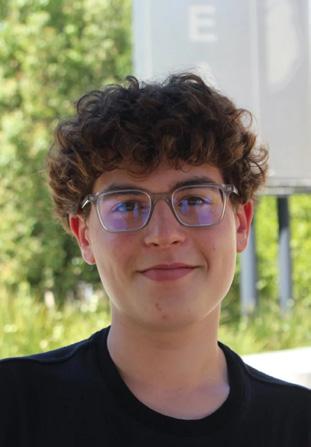
Ben Siegel “Perfectionist”

Morgan Baudler “Slack Warrior” Katelyn Chao “Event Enthusiast”

Allegra Hoddie “Chronicle(ly) Online”

Teagan Murphy “Musical Master”

Lia Lev “Most Collaborative”

Huraman Orujov “Best Critic”

Ameya Nori “Nonchalant Tryhard”

Aliyah Chowdhary-Fitton “Most Scottish”

Eileen Liu “Business Boss”

Emily Pecore “Cultural Conqueror”

Jonathan Weeks “Committed to Committments”

Zucker “Most Cultured”
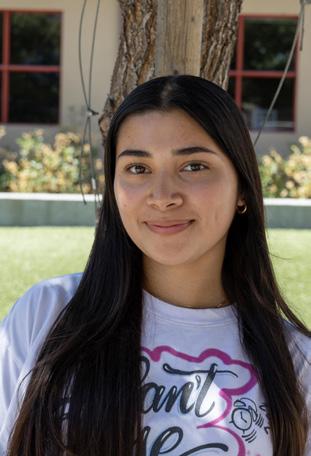
Paulina Cisneros Arreguin “Relentless Researcher”

Karen Martinez “Most Versatile”

Tatiola Sobomehin “Most Ambitious”

Benji Weiss “Political Professional”

Ellingson “Workhorse”

Kitty Cormican “Feature Fanatic”

Abby Medin “Finance Freak”
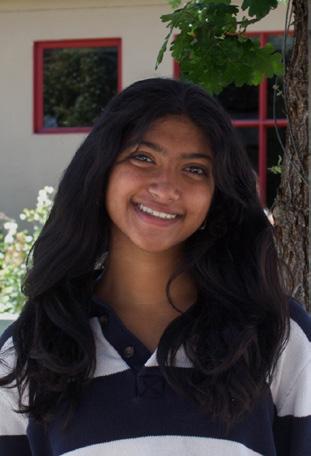
Varsha Sripadham “Punniest”
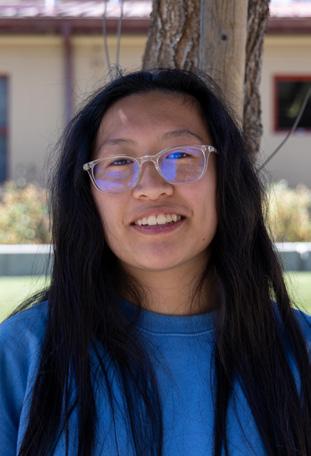
Weycene Yang “Illustration Fiend”

“Picture

Mateo Cuellar-Koh “Sports Savvy”

“Athletics Enthusiast”

“Grammar Police”
designed by Siboney Lynch








one with the issue,” one said.
“Everyone deserves to have a girlfriend. It’s just dumb because girls only want certain guys.”
Adolescence explores this entitled mindset, pulling back the curtain on a subculture where romantic failure is blamed not on lack of personal growth or social skills but on women themselves.
While many male students simply aired their frustration regarding dating culture, others went a step further, blaming their struggles on the unrealistic standards they believe society has forced upon them.
“You gotta be at least six feet tall to get a girlfriend,” a male student said. “If you’re not funny and confident, it’s an immediate turn-off to girls, but if you are confident, they’ll say you have an ego.”
“It’s not my fault I’m not that tall, but girls act like it is sometimes,” a male student said.
This outlook can lead young men to foster a quiet resentment toward women and a society they feel has set them up to fail. In their eyes, dating is an unfair system where only a select few men can succeed while the rest are left in the dust.
“It’s f*cking stupid, I swear. Talking to girls is rigged,” a male student said. Several echoed a similar sentiment: “Girls get to say they just hate all guys, but we know what would happen if I said that.”
These frustrations can be magnified by online communities that validate and amplify their anger, feeding into the broader incel mindset.
“It’s f*cking stupid, I swear. Talking to girls is rigged.”
The incel mindset is characterized by a belief that physical appearance entirely determines romantic success, leading to deep bitterness toward women, whom they often view as shallow.
Many incels see themselves as victims
of genetics and societal norms, blaming feminism, dating culture, and “Chads”— attractive men—for their loneliness. This worldview is often reinforced in online echo chambers that reject self-improvement, promote misogyny, and, in extreme cases, violent ideologies. While rooted in real feelings of isolation, the incel mindset can foster harmful and anti-social beliefs.
Fueled by online incel communities, what begins as subtle resentment over double standards can evolve into a more dangerous worldview, one that sees women as the enemy and romantic disappointment as evidence of a rigged system. In these spaces, vulnerability is replaced with blame, and isolation with toxic belonging.
Rooted in misogyny, content from the manosphere encourages men to adopt dominance and emotionally detach while navigating relationships. For some young women, these attitudes show up in everyday interactions—they feel men treat dating like a power struggle.
“He would say all these nice things, like I was beautiful and he liked me so much, but when he was mad, he would immediately say things like, ‘I wanna make you cry right now,’” a female student said.
These moments of tension expose how the emerging manosphere can influence young men, even if they don’t explicitly identify with it. “It’s an epidemic that stems from social media,” a female student said. “Even guys from great families who teach them excellent values can get sucked into the online algorithms.”
While Adolescence is fictional, the violence it portrays is not. In 2014, college student Elliot Rodger went on a killing spree, proclaiming he needed to give girls “exactly what they deserve: annihilation.” Before the attack, he uploaded a 141-page manifesto and a YouTube video outlining his motivations, expressing intense misogyny, social isolation, and resentment toward women and sexually active men. He saw himself as a victim of a society that denied him sexual and romantic attention and framed his violence as a form of “retribution.”
The consequences of these ideologies extend beyond one’s feed and chat rooms. When
left unchecked, they can harden into real-world hostility and hinder our ability to connect with and empathize across genders.
After conducting interviews with almost 30 students for this article, I was left unsettled. What concerned me most wasn’t just the content of what my peers said, but how easily they said it.
As a female student, I expected at least some hesitation, some concern for how their words might land. But many of the boys I interviewed, some of whom I’ve known for years, spoke openly about their grievances and blame toward women, even while speaking to one.
“It’s an epidemic that stems from social media. Even guys from great families who teach them excellent values can get sucked into the online algorithms.”
“I think women should be doing the cooking and cleaning stuff,” one male student said. The same student later remarked, “I don’t think I would date someone who didn’t want to do that stuff.”
While these men may not be incels, they still have the same underlying belief that women need to be kept in their place, that women’s value is tied to how well they serve men’s expectations. These kinds of comments may seem casual or simply old-fashioned, but they echo the gender dynamics that are often glorified by incel communities.
Furthermore, these weren’t anonymous internet users hiding behind a screen. These were classmates, teammates, and friends. If this is what they are comfortable sharing out loud, I worry about what goes unsaid.
“You can’t rape someone you’re dating, they’re always consenting by dating you,” a male student said.
I was stunned to my core. These comments weren’t just misinformed, they were dangerous. They reflected a broader societal failure to educate young people about consent, boundaries, and respect in relationships.
Every woman on campus knows that unsolicited sexual remarks about a woman’s body and appearance are commonplace.
It’s as if these boys believe it is their right to comment on a woman’s body without any regard for her autonomy or comfort.
This sense of entitlement extends beyond words and spills into actions. The other day, I witnessed a group of boys playing a “friendly” game, where the objective was to see who could be the first to look up the skirt of a girl sitting nearby. It’s disgusting, yet it’s laughed off, shrugged off as “boys will be boys.”
The culture these students are contributing to inherently facilitates the growth of radical ideologies, even if that is not their intention. It is time we stop ignoring the signs and start having the difficult conversations now, before these ideas grow into something far more dangerous. After all, we are all still adolescents. by Alisha Parikh-Briggs designed by Caitlin Smith photos courtesy of Elena Safonova and Netflix


The beignets at Nola are served deliciously warm in a generously sized basket, and they are the only item there truly worth the price. They are perfectly fluffy with heaps of powdered sugar on top, making each bite a sweet and airy treat. Three sauces accompany the dish. The chocolate sauce is a standout: liquidy, rich, and divine, with the right balance of sweet and bitter. The caramel sauce, on the other hand, leans a bit synthetic and simply can’t measure up to the chocolate. The jam offers a tangy contrast to the overall sweetness, providing a refreshing balance that elevates the dish overall.
by Leah Collins

The most popular dish on the menu, Shiok Sin gaporean Kitchen’s roti prata with curry sauce is a fantastic take on a classic appetizer. With a crunchy, golden brown exterior and a soft and doughy interior, it strikes a perfect balance of textures that makes every bite satisfying. In addition to textures, the flavors outdo themselves. The striking yet mild curry sauce was a phenomenal and flavorful addition, though the roti prata is so well made that it holds its own without the dip. Although the restaurant is now closed, this dish can still be enjoyed and ordered online through DoorDash.
The Mango Mochi pudding at Tong Sui is an absolute must-have for any first-time visitors and even for returning visitors craving something special. From the first bite, the mango’s freshness adds a vibrant sweetness that perfectly complements the light coconut flavor. It perfectly blends the goopy texture of the mango and mochi with the smooth consistency of the pudding, creating an irresistible mouthfeel. Its taste is reminiscent of traditional Hong Kong desserts like mango pomelo sago but with a modern twist. There’s no doubt that the Mango Mochi pudding takes the cake (or pudding) out of all the Tong Sui puddings.
by Jenna Lee and Weycene Yang

by Lilia Wilkiewicz



Despite its appearance, the Dirty Ube Latte at Covour Coffee is a surprisingly perfect balance of both ube and coffee flavors, with neither taste overpower ing the other. With a mild added sweetness, this drink doesn’t quite qualify as a dessert coffee, but rather something that could be ordered on a daily basis. The latte leans toward the milkier side, offering a smooth and creamy texture and protecting the ube from the overpowering flavor of coffee. Despite this, an extra espresso shot could easily be added to pack in some more caffeine or balance out the thickness of the ube sauce. If you’re looking to elevate your coffee game or simply add some color to your usual order, this ube delight is for you.
by Huraman Orujov


Ting overpowered by the flavors of a typical sauce. This delicious creation is something you’ll want to come back for.
by Lilia Wilkiewicz
he Cioccolata in Tazza at Cafe Venetia is by far the best hot chocolate on the Peninsula—a bold yet well-deserved claim for this unforgettable drink. With one sip of this thick and luscious hot cocoa, you’ll be transported to a cozy Italian cafe. The chocolate is smooth and strong, while committing to a powerful and refined taste of pure cocoa bean. It carries just the right amount of sweetness to balance out its richness. The authenticity of this drink, with its lack of a chalky, artificial aftertaste, will leave you unable to return to any powdered hot chocolate.
by Emily Pecore and Paulina Cisneros Arreguin
designed by Teagan Murphy
photos courtesy of Leah Collins, Jenna Lee, Huraman Orujov, Emily Pecore, and Lilia Wilkiewicz



